Laplace’s synchronization of the Jupiter sattelites Io-Europa-Ganymed gives to believe,
that also planets can be synchronized some way.
But principle of minimal interaction action
that was developed by Michael William Ovenden (1926-1987),
does not apply for outer planets.
So:
Long-term changes in solar activity has not yet been sufficiently explored or explained. The cause may be some resonance with a longer period arising in the solar system, but one can not completely eliminate the influence of some remote planet X.
See also: The influence of planets on solar activity.
Behind the periphery of observed solar system there still can reside bodies that in fundamental way influence on run of the known system and stay hidden.
Even relatively small bodies can – due to large distance – notably deflect barycentre of the system and so influence on motion of other bodies, solar activity and so on.
See also: Shape functions.
During last two centuries large scale of estimations for possible planet X was done. The estimations usually come from computations of orbital perturbations of outer planets or comets.
164.8 years: W.H.Pickering (1928), 188 years: W.H.Pickering, "Planet T" (1931) 209.2 years: W.H,Pickering, "Planet O" (revision, 1928) 217.4 years: Le Verrier (1847), 217.8 years: A.S.Guliev (1986) 251 years: C.Powell (revision, 1987), 251.3 years: R.M.Stewart, Crommelin (1930) 272.2 years: T.J.J. See, "Oceanus" (1904),275 years: Si (1904), 282 years: Lowell (1915) 292 years: Gaillot (revision, 1909), 299 years: Lovell (1915)
![]()
302 years: Gaillot (original, 1905), 302 years: C.Flammarion 310-330 years: Dr.T.Grigull, "Hades" (revision, 1902), 317-318 years: H.E.Lau 322 years: G.Dallet (1901), 327 years: Lowell's "Planet X" 336 years: W.H.Pickering, "Planet S" (1931), 336 years: Seidelman S1 (1971) 337-426 years: A.S.Guliev (1986), 360 years: Dr.T.Grigull, "Hades" (1902) 373.5 years: W.H,Pickering, "Planet O" (original 1909), 375 years: D.Todd (1877) 396.8 years: Tchebotarev (54 AU)
![]()
409.1 years: W.H,Pickering , "Planet O" (revision 1919) 420 years: T.J.J. See , "Trans-Oceanus" (1904) 464 years: Brudy (1972), 465 years: Gaillot (original, 1905) 494 years: C.Powell (1986), 505 years: Stephen Lowe 523.5 years: H.H.Kitzinger (original 1954, revize K.Schute) 536.1 years: Gaillot (po 1.revizi, 1909) 556.6 years: W.H.Pickering, "Planet P" (revision, 1928) 594 years: H.E.Lau
![]()
608 years: H.E.Lau, 610 years: T.J.J. See (1904) 650 years: Lowell (2.trans-neptunian), 650 years: H.H.Kitzinger (revision 1957) 656 years: W.H.Pickering , "Planet P" (revision 1931) 656 years: Seidelman P1,P2 (1971) 675.7 years: H.H.Kitzinger (po 2. revizi, 1957), 675.7 years: K.Schute (8 comets,1950) 677 years: F.M.E.Sevin , "Transpluton" (1946) 685.8 years: F.M.E.Sevin, "Transpluton" (revision, 1946) 700 years: Witmire,Matese (1987) 758 years (685-830 years) Feitzinger a Neuhasser (analysis of comets,83±5.3 AU)
![]()
>800 years 860 years: T.Landscheidt, "Transpluton" 1000 years:
Tchebotarev (100 AU), 1000 years: Forbes (1900),
1019 years B.Harrington (†1993) 1030-1190 years: A.S.Guliev (1986), 1066 years: Forbes (1887) 1400 years: W.H.Pickering , "Planet P"-original; 3600 years: Sitchin (fictive Sumerian "Marduk-Nibiru") 5200 years: Forbes (1900)Kuiper belt (30-100 AU) of asteriods (so called KBO objects) can be divided into two parts - inner 32-36 AU (180-220 years) and outer 42-46 AU (270-320 years).
Behind boundary 100 AU no object was found.
Adrian Brunini and Mario Melita tried to make this phenomenon clear (y.2002, with help of computer simulation) by existence of planet X (size of Mars) in distance c. 60 AU (see so called Kuiper cliff, i.e. marked decrease of number of bodies in range 44-50 AU). According to Jackson and Killlen there certainly does not exist planet with mass exceeding 5 MEarth in band 40-75 AU (otherwise it appeared in perturbations of Neptune.). It is assumed that comet 2000 CR105 (observed in distance 53 AU) is exposed to gravitational influence of unknown body (size of Moon or Mars, in distance c. 66 AU).In some planetary configurations position of possible planet X can be estimated.
E.g. the line of planetary alignment in eyars 719.29, 1147.48, 1575.66 (see Planetary patterns) slowly rotates with period approximately 4420 years.
During synodical period J-U the line J-U rotates by c. 59.189˚, i.e. after B= 428.18 years by 34.884˚.
Complete orbits is hence B* 360˚/34.884˚ = 4418.8 years.
Because angle of synchronization ω need not to be only 0˚, also other periods can be deduced:
| Number | Angle ω | Period B*360˚/(ω+34.88˚) | Orbit | ? Planet X ? |
| 0 | 0˚ | 4418.8 years | 269 AU | |
| 1 | 90˚ | 1234.3 years | 115 AU | |
| 2 | 180˚ | 717.34 years | 80.1 AU | |
| 3 | 270˚ | 505.59 years | 63.5 AU | |
| 4 | 360˚ | 390.35 years | 53.4 AU | |
| 5 | 450˚ | 317.90 years | 46.6 AU | Asteroid 318.13 years |
| 6 | 540˚ | 268.13 years | 41.6 AU | |
| 7 | 630˚ | 231.83 years | 37.7 AU | |
| 8 | 720˚ | 204.20 years | 34.7 AU | |
| 9 | 810˚ | 182.45 years | 32.2 AU | |
| 10 | 900˚ | 164.88 years | 30.1 AU | Neptun |
| 15 | 1200˚ | 124.83 years | 25.0 AU | (1998 QM107) |
| 20 | 1800˚ | 84.01 years | 19.2 AU | Uran |
| 144 | 12960˚ | 11.862 years | 5.2 AU | Jupiter |
Values derived just from positions of planets Jupiter and Uranus fit also exactly the period of Neptune.
4200 years: perturbation of planets Uranus-Neptune, (U,N/2) = 4233 years 4320 years: Hindu-Babylonian basic cycle (2*2160 years) 4400 years: 4 multiple of cycle of solar activity reversal (Charvátová) 4448 years: Stacey’s cycle Let us note that experiments to approximate motion of outer planets by 180 years or 320 years period lead to identical difficulty: ( (U,N), 9 (J,S)) = (171.44, 9 *19.86) = (171.44, 178.74) = 4200 years (16 (J,S), 2(U,N)) = (16 *19.86, 171.44) = (317.76, 342.88) = 4300 yearsLet us try to smooth planetary patterns of years 719.29, 1147.48, 1575.66 by circular orbit with approximately 390 year period.
Computation (according to Bretagnon heliocentric VSOP82) gives period 387.3 years (with longitude c. 157.3˚ for epoch 2451543.5), i.e. orbit at c. 53 AU (53.1 AU-53.2 AU).
Such planet X would have in observed configurations the following longitudes Lx:
|
Year |
LJ |
LS |
LU |
LN |
LX |
|
719,30 |
47˚ |
239˚ |
227˚ |
26˚ |
47˚ |
|
1147,48 |
86˚ |
72˚ |
266˚ |
241˚ |
86˚ |
|
1575,66 |
123˚ |
264˚ |
303˚ |
98˚ |
123˚ |
12.4.719 16.6.1147 17.8.1575
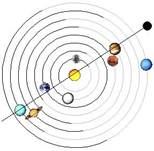
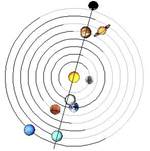
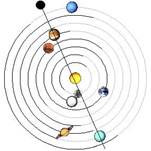
Such planet would have in years 2008-2012 the following longitudes [˚]:
(Bretagnon heliocentric VSOP87)
|
Rok |
LJ |
LS |
LU |
LN |
LX |
|
2008,00(2007 Dec 29) |
271,40 |
153,05 |
347,78 |
321,36 |
164,73 |
|
2009,00(2008 Dec 28) |
301,96 |
165,84 |
351,68 |
323,55 |
165,66 |
|
2010,00(2009 Dec 28) |
334,06 |
178,35 |
355,59 |
325,74 |
166,59 |
|
2011,00(2010 Dec 29) |
7,26 |
190,56 |
359,50 |
327,94 |
167,52 |
|
2012,00(2011 Dec 29) |
40,68 |
202,50 |
3,41 |
330,13 |
168,45 |

American astronomer William Henry Pickering (1858-1938) predicted in the y.1908 planet with period 373 years (51.9 AU, longitude 105˚). Later (1919) he modified its period to 409.1 years. Pluto was in the year 1930 observed at longitude 108.5˚, longitude of Pickering planet for year 1930 was 102.6˚ (longitude computed by Percival Lowell was 102.7˚), see Hypotetical planets (Paul Schlytter).
Our planet X with period 387.3 would be 1930,00(1929 Dec 29) at longitude c. 92.8˚
(LJ:72,8 ˚,LS:274,8˚, LU:17,9 ˚,LN:152,3˚, LX: 92,2 ˚), i.e. only c. 10˚ from position computed by Pickering and Lowel.
Could be the Pickering planet (in the shadows of Pluton) overlooked?
Because X/N ~ 7/3 resp. X/U ~ 14/3 positions repeats after 7 resp. 14 configurations.
When X pass near Uranus, Uranus is in perihelion, e.g. in year 1630 ( => beginning of Maunder minimum?) When X pass near Neptune, Neptune is in perihelion, e.g. in year 1879 ( àbeginning of descent to minimum?)Uranus near perihelion:
1630,89 J:346,51 S:219,17 U:166,57 N:218,02 X:174,22 1630 Nov 20 1713,77 J:341,21 S:151,75 U:161,28 N: 38,86 X:251,25 1713 Oct 5 1796,64 J:335,98 S: 84,56 U:156,04 N:220,11 X:328,28 1796 Aug 19 1879,52 J:330,79 S: 17,72 U:150,85 N: 41,03 X: 45,31 1879 Jul 5 1962,39 J:325,65 S:310,78 U:145,71 N:222,21 X:122,34 1962 May 20 2045,26 J:320,55 S:243,28 U:140,63 N: 43,19 X:199,37 2045 Apr 3 2128,14 J:315,55 S:175,48 U:135,60 N:224,30 H:276,40 2128 Feb 17 2211,01 J:310,57 S:108,12 U:130,63 N: 45,36 H:353,43 2211 Jan 2
20.11.1630 05.10.1713 19.08.1796
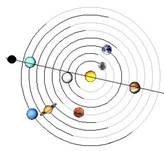
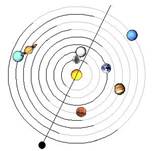
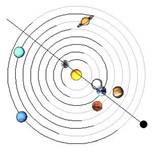
Neptune near perihelion:
1548,02 J:351,82 S:286,46 U:171,90 N: 36,70 X: 97,18 1547 Dec 27 1713,77 J:341,21 S:151,75 U:161,28 N: 38,86 X:251,25 1713 Oct 5 1879,52 J:330,79 S: 17,72 U:150,85 N: 41,03 X: 45,31 1879 Jul 5 2045,26 J:320,57 S:243,29 U:140,63 N: 43,19 X:199,37 2045 Apr 3 2211,01 J:310,58 S:108,13 U:130,63 N: 45,36 X:353,43 2211 Jan 2 2376,76 J:300,83 S:335,07 U:120,87 N: 47,52 X:147,49 2376 Oct 2 2542,51 J:291,23 S:199,49 U:111,31 N: 49,69 X:301,55 2542 Jul 2 2708,26 J:281,87 S: 65,10 U:101,96 N: 51,85 X: 95,61 2708 Apr 1
27.12.1547 05.10.1713 05.06.1879
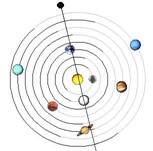
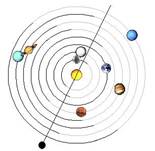
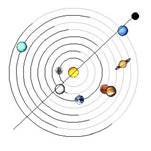
Division into 7 parts lead in case of period X=387.3 years to value X/7 = 55.33 years, i.e.. c. half of period 110.5 years, see Solar cycles.
For synodical periods the following relations approximately holds.
a/ 3-bodies
for (N,X) = 286.77 years (~24J) a (U,N)=171.44 years:Hence resonance 3/U–8/N+5/X = 0; it holds exactly for period X=389.2 years.
for (N,X) = 286.77 years (~24J) a (S,N)= 35.87 years (~3J, Bruckner’s period):Hence resonance 1/S–9/N+8/X = 0; it holds exactly for period X=387.0 years.
b/ 4-bodies
for (U,X) = 107.30 years a (S,N)=35.87 years:Hence resonance 1/S–3/U –1/N+3/X = 0; it holds exactly for period X=383.3 years.
for (S,X) = 31.88 years a (J,N)=12.78 years:Hence resonance 2/J–5/S –2/N+5/X = 0; it holds exactly for period X=376.8 years.
Period of resonance R2 works out as very low, but resonance – in period, for that reliable observation of Neptune exists – is relatively well satisfied in longitudes of planets:
(Bretagnon heliocentric VSOP87)
|
Rok |
LJ |
LS |
LU |
LN |
LX |
R1 |
R2 |
|
1600,00 |
139 |
207 |
36 |
152 |
145 |
25 |
26 |
|
1700,00 |
284 |
337 |
103 |
9 |
238 |
15 |
57 |
|
1800,00 |
90 |
129 |
177 |
228 |
331 |
4 |
19 |
|
1900,00 |
236 |
268 |
250 |
87 |
64 |
-16 |
0 |
|
2000,00 |
36 |
46 |
316 |
304 |
157 |
-16 |
23 |
|
2100,00 |
189 |
198 |
19 |
164 |
250 |
8 |
-51 |
|
2200,00 |
340 |
329 |
85 |
21 |
343 |
3 |
-13 |
(Value X=387.3 years ~ H/6 = 2318.1 years/6 = 386.4 years, where 1/H = 1/J-3/S+1/U+1/N, see Stable resonance )
Values of resonances computed according to relations 3/U–8/N+5/X = 0 and 1/S–9/N+8/X = 0 differ from values based on circular orbit of the planet.
Departures will be computed according to relations:
(Bretagnon heliocentric VSOP87)
|
Rok |
LJ |
LS |
LU |
LN |
LX |
∆LX(U,N) |
∆LX(S,N) |
|
1980,00 |
151 |
171 |
232 |
261 |
138.7 |
-5,1 |
-2,0 |
|
1990,00 |
96 |
286 |
276 |
282 |
148.0 |
-5,9 |
-1,3 |
|
2000,00 |
36 |
46 |
316 |
304 |
157.3 |
-4,9 |
-1,1 |
|
2010,00 |
334 |
178 |
356 |
326 |
166.6 |
-2,8 |
-2,4 |
|
2020,00 |
276 |
292 |
35 |
348 |
175.9 |
-0,5 |
-1,2 |
Hence (assuming respecting of resonances) e.g. in y.2010 planet would be expected at longitude 163.8˚÷164.2˚ (instead of 166.6˚), i.e. c. 164.4˚± 0.2˚.
(I.e. 3*LU –8*LN +5*Lx = 3*356˚ –8*326˚ +5*164˚ ~ 0˚, resp.1*LS –9*LN +8*Lx = 1*178˚ –9*326˚ +8*164˚ ~ 0˚)
Jupiter resonance with planet X?Saturn-Neptune pair seems to be synchronized with pair Uranus-X, see Jupiter.
Hence higher extremes at interval of 3 Bruckner’s period (c. 107-108 years) would follows.
E.g. analysis of wood from ancient Greece c. (-600,-400) showed 2 maxima in distance 108 years (Mariolopoulos,1962)
105 years: solar cycle (Precambrium) 107.61 years: 3*(S,N) =3*35.87 years 108 years: wood from ancient Greece
Conjunction U-X Conjunction S-N
------------------------------------------------------------
(107,84) 22,79 () 16,81 (36,19) 53,01 (35,29) 88,30
(105,05) 127,85 (35,24) 123,53 (36,19) 159,73 (36,63) 196,36
(107,46) 235,31 (35,73) 232,09 (35,15) 267,25 (35,57) 302,81
(109,68) 344,99 (36,55) 339,36 (36,41) 375,78 (35,40) 411,18
(106,28) 451,28 (35,18) 446,36 (36,00) 482,36 (36,72) 519,08
(105,44) 556,71 (36,06) 555,14 (35,18) 590,32 (35,43) 625,75
(109,02) 665,74 (36,36) 662,11 (36,63) 698,74 (35,62) 734,36
(108,64) 774,38 (35,15) 769,52 (35,76) 805,27 (36,61) 841,88
(105,27) 879,65 (36,25) 878,13 (35,32) 913,45 (35,26) 948,71
(106,64) 986,29 (36,14) 984,85 (36,61) 1021,46 (35,81) 1057,27
(109,76) 1096,05 (35,15) 1092,43 (35,57) 1127,99 (36,47) 1164,46
(107,02) 1203,08 (36,39) 1200,85 (35,46) 1236,30 (35,18) 1271,49
(105,11) 1308,19 (35,98) 1307,46 (36,63) 1344,09 (36,03) 1380,13
(108,26) 1416,44 (35,26) 1415,39 (35,37) 1450,76 (36,36) 1487,12
(109,32) 1525,77 (36,61) 1523,73 (35,65) 1559,38 (35,18) 1594,56
(105,63) 1631,40 (35,73) 1630,29 (36,61) 1666,89 (36,28) 1703,17
(105,82) 1737,22 (35,37) 1738,55 (35,26) 1773,81 (36,09) 1809,89
(109,57) 1846,79 (36,63) 1846,53 (35,84) 1882,37 (35,21) 1917,58
(107,93) 1954,72 (35,54) 1953,12 (36,39) 1989,50 (36,41) 2025,92
(104,94) 2059,66 (35,48) 2061,40 (35,21) 2096,61
(Computed using simplified VSOP87.)
Similarly as there exists occupied orbits in front of Jupiter (see Action of Jupiter) in ratio q=A/N =2/3 (Hilda) and q= 3/4 (Thule), we expect occupied orbits also
in front of planet X having the same ratios. From span X= 380-400 years we get:
|
Ratio |
Period |
Note |
|
2/3 |
253÷266 |
264.6 |
|
3/4 |
285÷300 |
286.59, Quaoar 288.0 |
|
4/5 |
304÷320 |
318.1 |
(Bodies are distributed unevenly on diagrams of Kuiper belt.Compression in opposition to planet X?).
Period 64 yearsConjunction E-R, conjunction J-N, conjunction S-X:
20.1.1882
16.1.1946
30.1.2010
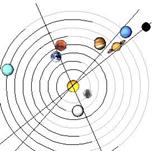
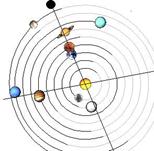
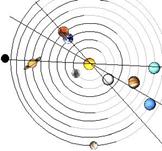
1946,05 M:246 V:288 E:117 R:115 1946 Jan 16
2010,09 M:218 V:321 E:130 R:130 2010 Jan 30
(32,09) 1307,63 (12,84) 1306,70
(12,81) 1319,51 (12,81) 1332,33 (12,73) 1345,06 (12,73) 1357,79
(32,17) 1339,80
(32,20) 1372,00 (12,70) 1370,49
(12,70) 1383,20 (12,73) 1395,93 (12,76) 1408,69 (12,79) 1421,47
(32,14) 1404,14
(31,98) 1436,12 (12,84) 1434,31
(12,84) 1447,16 (12,87) 1460,02 (12,84) 1472,86 (12,84) 1485,71
(31,87) 1467,99
(31,70) 1499,70 (12,79) 1498,49
(12,73) 1511,22 (12,73) 1523,95 (12,68) 1536,63 (12,73) 1549,36
(31,62) 1531,32
(31,60) 1562,91 (12,73) 1562,09
(12,76) 1574,85 (12,79) 1587,64 (12,84) 1600,48 (12,84) 1613,32
(31,68) 1594,59
(31,76) 1626,35 (12,87) 1626,19
(12,87) 1639,06 (12,81) 1651,87 (12,76) 1664,63 (12,76) 1677,39
(31,90) 1658,25
(32,03) 1690,28 (12,70) 1690,09
(12,70) 1702,79 (12,70) 1715,50 (12,73) 1728,23 (12,79) 1741,02
(32,17) 1722,45
(32,17) 1754,62 (12,79) 1753,80
(12,84) 1766,64 (12,87) 1779,51 (12,87) 1792,38 (12,84) 1805,22
(32,17) 1786,79
(31,98) 1818,77 (12,81) 1818,03
(12,79) 1830,82 (12,73) 1843,55 (12,70) 1856,25 (12,73) 1868,99
(31,90) 1850,67
(31,70) 1882,37 (12,70) 1881,69
(12,73) 1894,42 (12,76) 1907,18 (12,81) 1919,99 (12,84) 1932,83
(31,65) 1914,02
(31,60) 1945,62 (12,84) 1945,67
(12,87) 1958,54 (12,84) 1971,38 (12,81) 1984,20 (12,79) 1996,98
(31,62) 1977,24
(31,70) 2008,95 (12,73) 2009,71
(12,73) 2022,44 (12,70) 2035,15 (12,70) 2047,85 (12,73) 2060,58
(31,87) 2040,82
We will try to observe possible influence of hypothetical planet X on solar activity - with help of theory of barycentric deflection (see Solar activity)¨
Planet X with c. 390 year period would influence planets Uranus and Neptune with c. 856 years period, i.e. 2B (see Babylonian period). Synodical period of Uranus and Neptune with regard to body with c. 390 year period makes approximately: (U,X) = 107 years, (N,X) = 285 years in ratio 3:8 with common period 856 years=2B. (Similarly e.g. for period 717 years , where (U,X) = 95 years, (N,X) = 214 years, we get ratio 4:9 with common period also 2B).
The dependence is approximated by function:
cos(2π*(x-2027)/286.8)+cos(2π*(x-2005)/107.3)+cos(2π *(x-1907)/171.4),
where 286.8=(N,X), 107.3=(U,X), 171.4=(U,N).
Influence U-N is draw in black, influence U-X in light blue and influence N-X in blue color.
Total influence in marked in red:

Comparison with graph derived from shifts of conjunctions J-S with regard to U-N (see Babylonian period ).

Each graph cover approximately 856 years period.
(-2706,-1850)Opposition Maxima U-X:-2608,-2497,-2392,-2287, -2177, -2068, -1964, -1858 U-N:-2550,-2378,-2208,-2037,-1865 N-X:-2562,-2275,-1989 Schove:

Conjunction Minima U-X: -2448, -2337, -2230, -2126, -2018, -1907 U-N: -2465, -2294, -2123, -1952, N-X: -2418, -2131, -1846 Schove:
Opposition Maxima U-X: -1747, -1640, -1536, -1427, -1317, -1212, -1107, -996 U-N: -1694, -1522, -1350, -1178, -1005 N-X: -1703, -1415, -1128 Schove:

Conjunction Minima U-X: -1802, -1697, -1587, -1478, -1374, -1265, -1156, -1050 U-N: -1781, -1609, -1437, -1267, -1092 N-X: -1846, -1559, -1271 Schove:
Opposition Maxima U-X: -888, -784, -677, -566, -460, -356 U-N: -833, -661, -488, -316 N-X: -842, -556, -268 Schove: Maximum of Alexandria (-350)-246

Conjunction Minima U-X: -946, -837, -727, -622, -517, -406, -299, -194 U-N: -919, -746, -573, -401, -230, N-X: -984, -699, -412 Schove:
Opposition Maxima U-X: -249, -137, -33, 73, 185, 291, 396, 504, 614 U-N: -145, 27, 198, 362, 540, N-X: 20, 305, 592 Schove: M(186-196), M(290-302), M(354-372): Late Roman maximum (4.century), M(501-531): Byzantine maximum (6.century), M(567-585)

Conjunction Minima U-X: -87, 24, 129, 234, 344, 448, 557, 664 U-N: -58, 113, 284, 455, 626 N-X: -124, 163, 453 Schove: M(26- 37), M(112-157), M(203-272), M(326-336), M(380-484), M(613-637): Dark Age minimum (660-740)
Opposition Maxima
U-X: 719, 824, 935, 1043, 1147, 1254, 1365, 1471
U-N: 711, 882, 1053, 1224, 1394,
N-X: 872, 1167, 1452
Schove: M(714-724), M(829-840), M(925-938),
M(1118-1151): Middle-age maximum (1120-1210),
M(1362-1382): Late Medieval maximum (1360-1380)

Conjunction Minima
U-X: 663, 775, 881, 986, 1094, 1204, 1309, 1415, 1525
U-N: 797, 968, 1138, 1309, 1480
N-X: 735, 1023, 1309
Schove: M(882-912), M(982-990),
M(1010-1082): Oort‘s (Norman) minimum (1010-1090),
M(1212-1353): Wolf‘s (medieval) minimum (1260-1350),
M(1391-1492): Spoerer‘s minimum (1400-1510)
Opposition Maxima
U-X: 1576, 1685, 1794, 1899, 2005, 2116, 2223, 2327
U-N: 1565, 1736, 1907, 2078, 2249,
N-X: 1739, 2027, 2313
Schove: M(1528-1581), M(1718-1738),
M(1769-1788): Modern maximum (1780),
M(2000-2020): New-age maximum,
M(2225-2250),

Conjunction Minima
U-X: 1633, 1733, 1845, 1955, 2060, 2166, 2275, 2384, 2488
U-N: 1650, 1821, 1992, 2163, 2334, 2506
N-X: 1595, 1883, 2170, 2456
Schove: M(1587-1611),
M(1634-1698):Maunder‘s minimum (1646-1699),
M(1798-1823):Dalton‘s (Napoleonian) minimum,
M(1878-1902), M(2110-2210)
Period of 390 years (see above) corresponds approximately to Mayan period Baktun 394.24 years (144000 days).
We will observe configuration that satisfy the following conditions:
Jupiter near its perihelion Jupiter in opposition to Saturn Mars in opposition to EarthWe get dates:
302,80 J: 5,96 S:196,10 U:247,41 N:196,60 H: 19,76 302 Oct 17 AD
1156,94 J: 8,12 S:193,94 U:305,10 N:262,28 H: 93,68 1156 Dec 2 AD
2011,08 J: 10,01 S:191,54 U:359,83 N:328,12 H:167,60 2011 Jan 28 AD
17.10.302 2.12.1156 28.1.2011
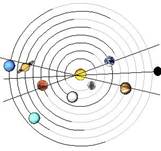
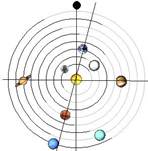
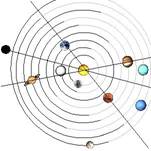
Hypothetical planet X is here always near to opposition to U and N - so these configurations will appear in periods of higher solar activity (see Planet X and solar activity).
Now let us change the second condition to:
Jupiter in conjunction to SaturnWe get dates:
-124.29 J: 5,20 S: 1,57 U:216,57 N:341,70 H:342,79 126 Sep 19 BC
729.86 J: 7,13 S: 0,28 U:276,89 N: 49,40 H: 56,71 729 Nov 4 AD
1583.98 J: 8,03 S:358,95 U:332,33 N:116,87 H:130,61 1583 Dec 21 AD
4.11.729 21.12.1583
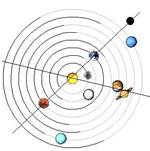
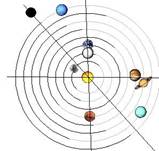
Observed configurations step with Babylonian period. Twelve of such periods cover interval c. 5125 years:
-3113.81, -2886.73, -2259.66, -1832.59, -1405.51, -978.44,
-551.36, -124.29, 302.80, 729.86, 1156.94, 1583.98, 2011.08
And the beginning and ending dates roughly make boundary of Mayan calendar according to GMT-correlation (3113 BC-2012 AD).